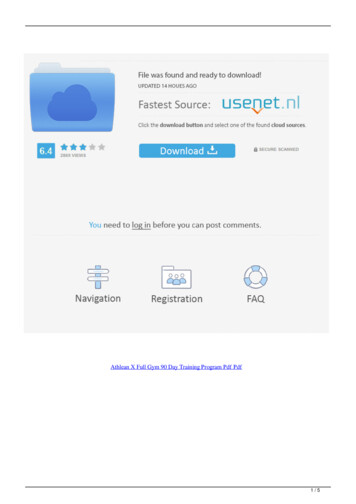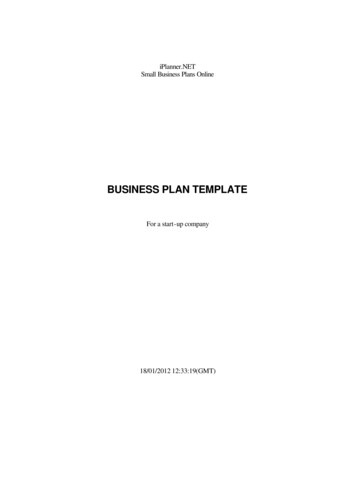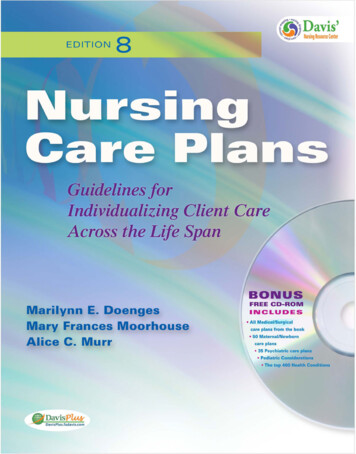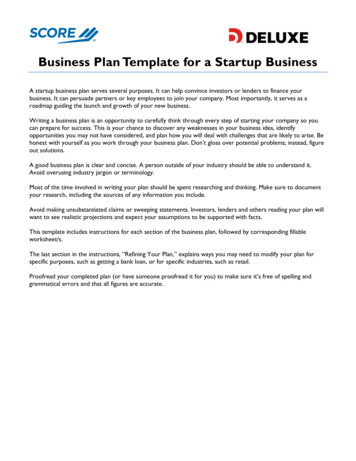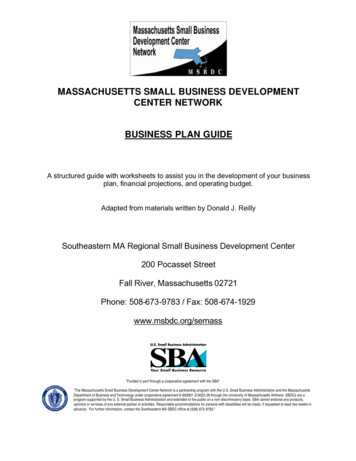
Transcription
MASSACHUSETTS SMALL BUSINESS DEVELOPMENTCENTER NETWORKBUSINESS PLAN GUIDEA structured guide with worksheets to assist you in the development of your businessplan, financial projections, and operating budget.Adapted from materials written by Donald J. ReillySoutheastern MA Regional Small Business Development Center200 Pocasset StreetFall River, Massachusetts 02721Phone: 508-673-9783 / Fax: 508-674-1929www.msbdc.org/semass“Funded in part through a cooperative agreement with the SBA”“The Massachusetts Small Business Development Center Network is a partnership program with the U.S. Small Business Administration and the MassachusettsDepartment of Business and Technology under cooperative agreement 6-603001 -Z-0022-26 through the University of Massachusetts Amherst. SBDCs are aprogram supported by the U. S. Small Business Administration and extended to the public on a non-discriminatory basis. SBA cannot endorse any products,opinions or services of any external parties or activities. Reasonable accommodations for persons with disabilities will be made, if requested at least two weeks inadvance. For further information, contact the Southeastern MA SBDC office at (508) 673 -9783.”
BUSINESS PLAN GUIDEThe following format has been designed to give the business planner a brief list of some of thequestions one must address before beginning to write each part of the plan. The list ofquestions is in no way complete but is intended to assist the planner in analyzing some of theareas that must be considered. After the lists of questions is an example of what a commonbusiness plan begins to look like. The examples are incomplete and are only intended to givethe first time planner an idea of the format.These pages are intended to help you in organizing your thoughts and to give some very basicexamples to assist you in writing your business plan. The examples are very short and concise.They are only intended to show you one standard type format. Your business plan should bemuch more specific and extensive and should present your ideals, perceptions and goals. Note:Your first attempt to put together a business plan will probably not be the last. There are over50 examples of sample business plans at www.sba.gov.PART 1 - BUSINESS PLAN NARRATIVETHE COVERThe final product should be a well-structured document that distinctly identifies its content.The cover should be short and concise clearly indicating:1. Purpose of the plan2. Company/person name3. Address4. Telephone number5. Proposal writer if different from the owner6. Date of the proposalPLAN OBJECTIVEThis should be a brief, executive summary of the key elements of the business plan. Itspurpose is to capture the interest of prospective investors.There are two basic reasons for the development of a business plan.?To be used as an Operating GuideTo be used as a Financing ProposalIf the plan is to be used as an internal operating and policy guide, the purpose should be clearlyand simply stated. If the plan is to be used as a financing proposal the statement of objectivesshould include more detailed information which will let the reader (lender or investor) knowimmediately what the amount and intent of the funds will be used for.1
The lender or investor will want to know immediately:?Who is asking for the money?How much is being requested?How the monies will be used?How the funds will be repaid?TABLE OF CONTENTSEvery business-planning document should contain a Table of Contents. This page will allow thelender or investor to quickly review your document and determine if all the criteria for making adecision are contained in the package.All of the components suggested in the following sample plan are necessary for a completecomprehensive plan. Additional data or information may be added as necessary.The Table of Contents cannot be completed until you have decided on the format andcomponents. It will be the last task in completing the plan. The Table of Contents shown in thisexample may not match your Table of Contents exactly.QUESTIONS:?Have you titled each part of the plan?Have you included all of the parts in the Table of Contents?BUSINESS PROFILEThis section of the business plan should outline the business profile. Indicate the type of business,its organizational structure, the principals, and the type of industry.Who are you? What are you? Where are you going? These questions must be clearlydefined in your business plan.QUESTIONS:Who are you?Name of the businessLocation of the businessOrganizational structure of the business; e.g., Sole Proprietorship,Partnership, Corporation, “S” Corporation, Limited Liability Companyor General Limited Liability Partnership (LLC or LLP)Management and owner namesHours of operation2
What are you?Start- up, ongoing, expanding business, acquisitionRetailer, manufacturer, wholesaler, service companyType of product or service you offerIf product, where do you get your products from – will you manufactureMarket and customers you serveIf you have an existing business: brief history including financial performanceIf an acquisition, why is the seller selling, how will you grow the businessIf an expansion, why, and what will the effects be on the businessWhere are you going?What changes do you anticipate for the business over the next 3 yearsWhat goals do you have for the business over the next 3 yearsWhy will you be a success?MARKET PROFILEBefore deciding on a business venture you should have already determined that there is a needfor your product or service. Now you must develop a plan to reach the potential customers.Development of a marketing strategy begins with your expertise. You must know the wants andneeds of your potential customers and develop a strategy to entice those customers to buy fromyour company.Your sales potential depends on varying factors, location, product line, traffic, competition, theeconomy, etc. It is imperative that you examine all of the factors to develop your sales potential.Examine your market and the competition and its pricing structure. You should have the answerto the following questions:QUESTIONS:?Is there a real need for the product or service to be provided?How do you know?What industry data do you have?Is the market growing or declining? Why?What are the important trends in your business and industry?Who is the target customer? Customer segment? (geographic, demographic,psychographic)What is unique about the product or service?Why should the customers buy from you instead of the competition?Will prices be competitive?How can you attract customers to buy from your company?What will your sales and marketing efforts cost?How can you keep the business? Will you have repeat sales?What will be the channels of distribution? (how will you sell and deliver yourproduct or service)Will you use the internet?3
COMPETITION PROFILEIn order to determine the feasibility of any venture, the competition must be analyzed in depth.By studying your competition you should be able to determine the viability of your product orservice. You should have a thorough knowledge of the strengths and weaknesses of yourcompetitors and the advantages and disadvantages you have in comparison to them. Yourventure will be successful only if you can be competitive and still make a profit.Your competition can put you out of business. On the other hand, your competition can allowyou to penetrate the marketplace if they are not serving the needs of their customers. And,believe it or not, your competition can actually become a source of business for you.Do not attempt to enter a marketplace that is already saturated with your type of business orservice. Your share of that market may not be enough for economic survival. Avoid making themistakes of your competitors but also incorporate their positive practices.You must be aware of the competition's position in the market and their strategic moves that willaffect your business. Counter the competition's moves with your own strategies. If possible,attempt to get yourself into a position in which the competition has to counter your strategicmarketing moves.The easiest way to keep abreast of the competition's strategies is to develop a personalrelationship with the salespeople who call on both you and the competition. They generally knowwhen your competition is planning an advertising campaign, sale or promotion. They can be awealth of information to you.QUESTIONS:?Who are the competitors?How close are the competitors?How will the competition react to your entry into the market?What are the weaknesses of the competition? How can you capitalize onthem?What are the strengths of the competition? How can you use them?What are the sales trends of the competition? Why?What percent of the competition’s market can you expect to take?How competitive can you be with pricing?How do you compare in quality?How do you compare in service?LOCATION, FACILITIES, EQUIPMENT AND ECONOMYA high priority in starting or buying a business is its location. You must appraise the overallbusiness picture. Where is the location? How is the location to be equipped? Does the facilityrequire any special considerations, i.e. ceiling heights, floor weights, loading docks, lighting, andstorage? What is the general appearance of the neighborhood? Is the market nearby? Whatare the zoning, parking, traffic and transportation situations, and labor market?Depending on the type of business, each consideration must be analyzed. The criteria forlocation will generally be dictated by the industry, retail, manufacturing, wholesale or service.Each factor must be considered according to its importance and cost.4
Consider the equipment needs of the business. The facilities must be able to accommodate theequipment. The cost, style and appearance will vary with the type of business. Noise andpollution considerations must be analyzed. Select your location carefully. Thoroughinvestigation of the location and facility requirements may save you much anguish in the future.Get adequate legal advice before signing any lease or purchase agreement. Some businessesare directly affected by the economy or by specific regulations. Be sure to be aware of theseissues.QUESTIONS:?How much space is needed?Will you buy or lease the building space?Is the site properly zoned for your type of business?Will you have a lease? How long?What is the cost per square foot?Is the facility cost efficient?How much renovation is necessary?What are the electrical, sewer and utility services? Are they in place?Is the facility adequate to house your equipment?Is there adequate public transportation, commercial transportation?Is the proximity to the airport, highway, railroad or seaport a factor?Is there adequate parking for your customers, employees?Can you expand if necessary?What services are provided, rubbish, snowplowing?What type of equipment do you need? Can you find used equipment?If you will be manufacturing, describe the manufacturing process andphysical requirements.If relevant to your business: What’s happening in the local, nationaland/or global economy? What are the trends? Will you have regulatory orenvironmental issues to deal with?MANAGEMENT PROFILEExplain in detail your business qualifications and also those of your managers. Directexperience in the industry is important for your understanding of the business. Explain who willbe the manager, who answers to whom, what types of skill the managers possess. Considerthe following:?Will your company employ the services of an attorney, an accountant,other professional people?How will the managers of the enterprise be compensated?What is the chain of command?What experience does your management possess?All of the above information is essential to the plan. You may wish to develop job descriptionsfor all of your employees, both management and line so that each employee knows what isrequired of them.5
QUESTIONS:?Who will manage the business?What experience is necessary?What special training, education or abilities do you or your managershave?What management experience do you have?Who is the company's accountant?Who is the company's attorney?Who is the company's insurance advisor?What other resources are available to management?Does the corporation have a board of advisors or directors?If necessary, who will manage in the absence of you or the manager?PERSONNEL PROFILEThe personnel requirements for any business are usually unique to that particular business.Wage rates are generally dictated by the skills required to complete the task assigned. Thearea or the going rate for the industry may also affect wage rates. Therefore each individual jobmust be analyzed and tasks designated.Develop job descriptions for each job category. Analyze the educational level, skill required,and working conditions. If possible develop wage scales for each job depending uponexperience, seniority and importance of the position.Develop an organizational chart clearly indicating the chain of command. The moresophisticated your company’s structure the more important the management team becomes.If the business is to be departmentalized, indicate clearly the lines of authority and duties.Management progression is extremely important. If you are ill or injured who will manage inyour absence? Before you hire your first employee, full or part time, you are required by law tohave Workmen's Compensation Insurance in place. The rates are determined by the amount ofrisk involved in the job tasks and are set and regulated by the state. You must also have afederal and state identification number to deposit taxes withheld and the company's taxobligations.If your company is a proprietorship with no employees, you are not required to have Workmen'sCompensation Insurance or tax identification numbers. If your company is a partnership orcorporation you are required to have them.QUESTIONS:?What are your
MASSACHUSETTS SMALL BUSINESS DEVELOPMENT CENTER NETWORK BUSINESS PLAN GUIDE A structured guide with worksheets to assist you in the development of your business plan, financial projections, and operating budget. Adapted from materials written by Donald J. Reilly Southeastern MA Regional Small Business Development Center 200 Pocasset Street
